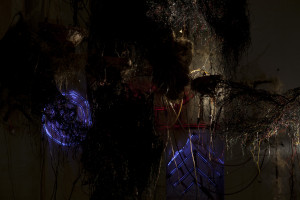Em’kal Eyongakpa: Tahjèsè #3i / barɨŋ báchɔ́kɔrɔk #4
–










In 2019 The Showroom presented Tahjèsè ## 3i / barɨŋ báchɔ́kɔrɔk #4, an immersive sculptural environment and the first solo commission in the UK by artist Em’kal Eyongakpa. The installation forms part of sǒ bàtú (2016-), an ongoing body of work including live sonic sketches, processions and kinetic sound sculptures through which Eyongakpa explores ideas around portals, crossings and water in relation to resistance movements from the oil and natural gas-rich region of the Gulf of Guinea and beyond.
Tahjèsè ## 3i/ barɨŋ báchɔ́kɔrɔk #4 constituted interacting sculptural, sonic elements developed both onsite at The Showroom and at Eyongakpa’s studios throughout summer 2019. The exhibition title is written in Kɛnyaŋ, a language widely spoken in the Cross River basin in Cameroon. ‘Tahjèsè’ in Eshobi, Southwest Cameroon, is located approximately seven kilometres from the confluence of the river Manyu, and is believed to be the site of a portal from where ‘barem’ (ancestral spirits) emerge periodically to chant, luring people into long, unconscious states. ‘barɨŋ’ translates as veins, and ‘báchɔ́kɔrɔk’ as clock birds, so ‘barɨŋ báchɔ́kɔrɔk’ literally means veins of clock birds. ‘sǒ’ translates as to bathe or to cleanse and ‘sǒ bàtú’ is to bathe one’s ears, or ear bath. These subtitles consequently have multiple readings that draw from indigenous aesthetics recurrent in the Manyu region and clock/time signatures from rhythmic structures, which together informed Eyongakpa’s new water-based sound sculptures, or rhythm generators, for sǒ bàtú reflections.
Tahjèsè ## 3i/ barɨŋ báchɔ́kɔrɔk #4 included a multi-channel sound composition produced from a combination of field recordings made in and around Tahjèsè and from various bodies of water – streams, rivers, lakes and oceans – in the former Southern Cameroons and the Mediterranean; as well as recordings from water pipes and wind channelled through air vents in Eyongakpa’s workspaces. At The Showroom the composition interacted and alternated with sounds generated by water-based polyrhythmic sound sculptures, and found sound excerpts from the ongoing conflict in former Southern Cameroons.
This immersive, sonic environment was set in an electronic organic installation including fungal mycelium-scapes embedded with texts, plant fibres, electric wires and coconut shells. Structures of hardened cotton and plant fibre were suspended and interwoven with polyrhythmic sound sculptures, whilst the resulting sounds were transcribed visually by custom-made, touch-triggered and midi-controlled sound-light interfaces, developed by Eyongakpa with a constellation of collaborators.
Since 2016, Eyongakpa’s sǒ bàtú has developed across a range of sites internationally. Forms that the ideas around sǒ bàtú have taken include an installation in a cluster of historic prison cells under the colonial-era Batavia House in Fatahillah square, Central Jakarta; and a cycling procession in which live, analogue, water- and oil-based kinetic sound sculptures were carried on Dutch bakfiet bicycles in the Bijlmer, Amsterdam where his studio is based, from Ken Saro-Wiwa Street to Nelson Mandela Freedom Park. Since 2017, sonic dialogues and conversations with sound artists, poets and musicians have included: mbì-ɛshobì inter-sessions at Bɔ́ Bɛtɔk / Bijlmer station in Amsterdam, and Arhgbrou 4.3 which premiered in Amsterdam and Lagos. Workshops continue to be developed by Eyongakpa with displaced communities focused on building analogue rhythmic systems.
Curated by Elvira Dyangani Ose and Lily Hall.
This project was supported by The Dutch Ministry of Foreign Affairs and The Embassy of the Kingdom of the Netherlands.


